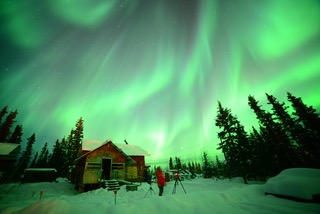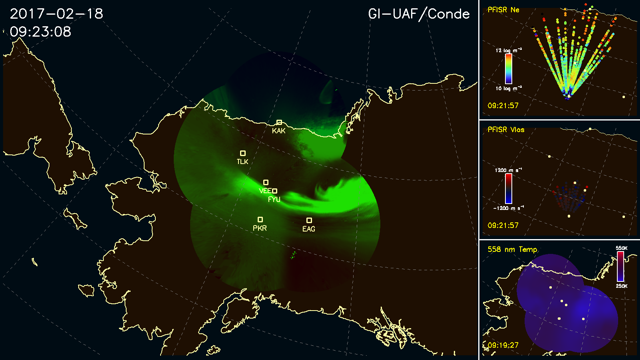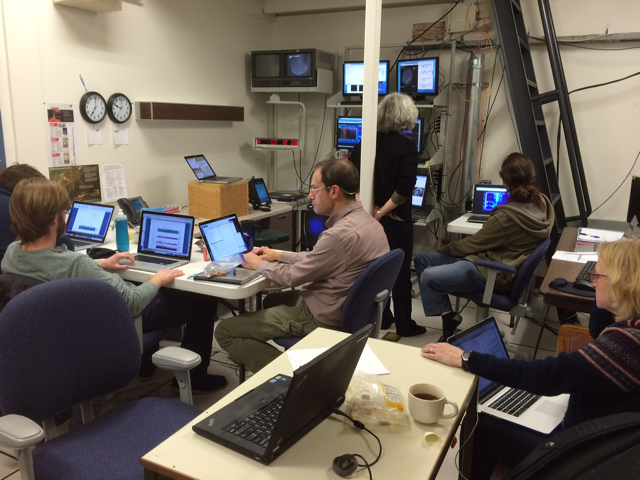ISINGLASS Field Campaign Updates
1 March 2017
Day 13 -- More weather delays
Short update for tonight. We were down for winds all night, which was really unfortunate. I saw the most intense substorm I have ever seen (1000 nT negative bay). Amazing, amazing aurora. Hopeful for tomorrow night — temperatures continue to drop (headed to -20 F or colder), which should help reduce the winds.
24 February 2017
Day 8 -- Weather delays
The weather here has turned bad and there has been virtually no chance that we could launch the second rocket last night or tonight and the weather looks worse for tomorrow. The good news is that we’ve been able to use that time to review the data from rocket #1 to see if there were any issues that can be tweaked on the second rocket.
There are great photos and news blurbs about the first rocket at:
There was a live youtube feed of the launch at the link below. That is a very long video but just go to the last 10 or 15 minutes and you can see the aurora we launched into and the actual countdown. You don’t get to hear the science discussions that we’re going on at the time, though. https://www.youtube.com/watch?v=sB5NkuSkX0U
22 February 2017
Day 6 -- Rocket A Launched!!!
Yup, one down, one to go!! The plan has been to launch the rockets into two different types of aurora. From the beginning, one was to be launched into a substorm and that is the one that we launched just now. We were lucky to (finally) have very good and cooperative solar wind conditions which made predicting the susbtorm expansion phase fairly predictable.
The electroject was several hundred nT. Basically, this means that the substorm had a lot of energy, a lot of aurora. The image below with the green coloring shows the extent of the aurora mapped across Alaska. The other image is from Venetie, a key downrange site and the location where the rocket flew over (ignore the colored streaks in this image, that is from my cellphone camera).
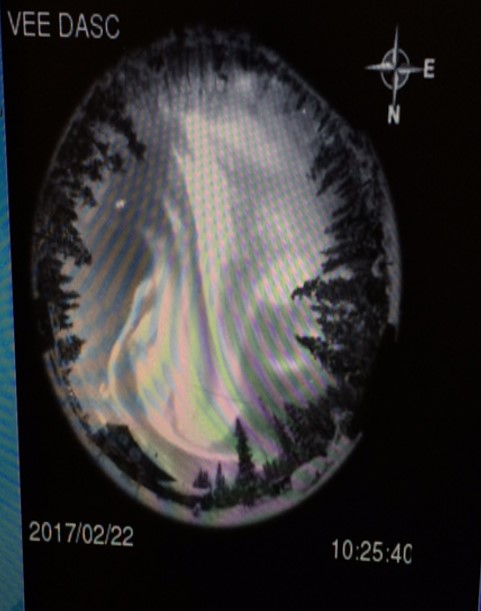
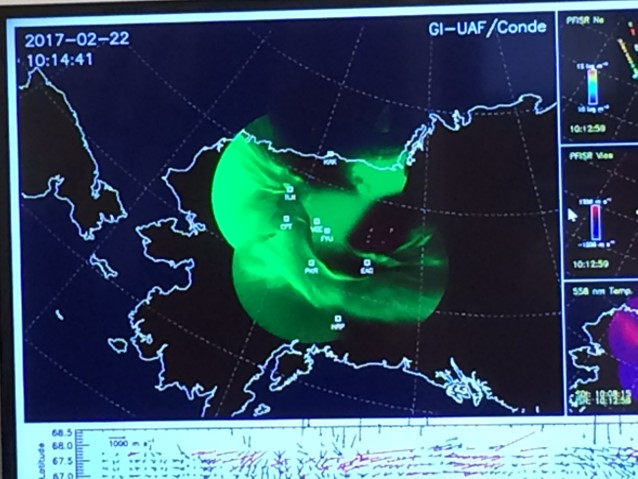
At this point, we know we have excellent radar, magnetic and optical data from the ground. We’re still looking through the onboard data from the payload but as far as we can tell the instruments on the main payload worked well, but this is extremely preliminary. There are questions we have with the four small “BOBS”, subpayloads that were included to separate from the main payload to provide an array of measurements.
Lots of happy people here right now!!
21 February 2017
Day 5
I did not send out an update last night. Not too much going on.
Tonight was not much better, we seem to be plagued by clouds all over Alaska. Auroral activity was moderate thanks to a steady solar wind. In fact, the solar wind has been remarkably steady for the last 3 days. Take a look at the image below, from the SOHO satellite. This is our starting point. It turns out that the sun rotates with a period of about 27 days, so the features that you see (the bright spots and the dark spots) appear to move from left to right over the course of about 13 days. As the sun rotates, it spews out solar wind that flows to Earth.
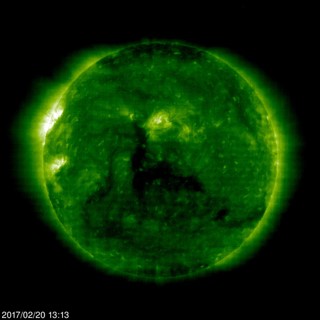
Most of the solar wind that reaches us originates from the far right side of the image. In this particular image, you can see that there is not much of anything going on in that region. We mostly care about the bright and dark spots. The bright spots are “active regions” and spew out more energy that other areas. The dark regions are “coronal holes” and send out “high-speed streams”. Since this solar wind travels much faster than from the active regions, we tend to get solar wind from coronal holes when they are near the center of the image. The good news is that we’ve been fed that same high speed stream for 3 days now; the bad news is that the orientation of the magnetic field that is embedded in the solar wind has been such that the energy from that solar wind has not been able to penetrate Earth’s magnetic field very effectively. That’s ok, we’re patient people. And it’s been mostly cloudy anyway, though the forecast for tomorrow looks to be pretty good and we are expecting clear skies.
On a different note, temperatures here have been relatively warm (that is…. relatively!). I’ve been on other launches where day after day the temps have been near -40 F, getting below -50 F at one point. This time around it’s been warm. This morning it was a balmy -5 so I decided to go for a run. The other picture below shows how that went!!
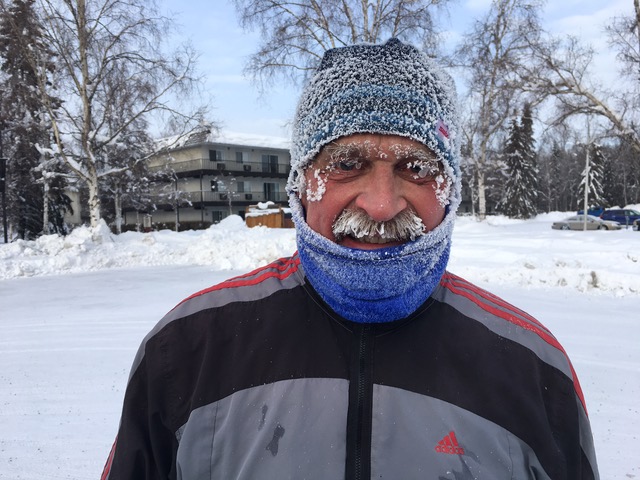
19 February 2017
Day 3: Tough night tonight!
Skies were generally clear, certainly good enough for us to be able to see aurora. The solar wind conditions were generally very good in terms of the solar wind speed and density. Like last night, though, the solar wind magnetic field remained mostly in the wrong direction (the z-component was positive and we really want it to be negative). What we got repeatedly was nice aurora (not great, but nice) over Venetie. At times, a broad auroral arc would grow in brightness, we would drop the count from T-10 to T-3 minutes and just fidget until it faded away and then recycle the clock to T-10.
In general, we sit and wait and watch with the rocket at T-10, meaning we are 10 minutes away from launching. At that point, instruments are not turned on and not too much is happening. When we think we might have the chance to launch, we call for the count to be picked up. As the clock drops from T-10, lots of things happen like roadblocks get put in place, instruments get turned on, etc., etc. We have a built-in possible “hold” at T-3 minutes, where we can sit for about a half hour. I think we went through this routine 3 times tonight. It is not true that we do this just watch people scramble, that would be mean. Each time we brought the count down, though, the aurora faded — clearly, the aurora gods are being mean to us for some reason. That’s ok, we’ll win the battle eventually!
The photo below is of the roof of the building that I am sitting in. What you see are lots of domes with cameras inside of them. Yes, we have a “thing” for fancy cameras! We also look at data from many other instruments, some of which are installed nearby, some from different sites in Alaska and some from satellites far, far away. Well, that’s the scoop for tonight, we’ll be back tomorrow with renewed energy… I hope!

18 February 2017
Day 2: Greetings, rocket fans!
Well, it was quite an interesting night. We came fairly close to launching one of the two rockets but did not. The good news is that we had aurora where we needed it, the bad news is that it was too weak for what were looking for. In order to launch, we need to have reasonably strong electric fields (that we would see using the various radars here) which never developed. Not quite sure why it didn’t cooperate, but it clearly was not the sort of event we are looking for. And so goes the auroral roller coaster!!
The image below shows what we were looking at for a couple of hours or so. PKR is where we are sitting (Poker Flat), VEE (Venetie) is a key station where we have the cameras aimed up to the sky to show us the fine structure in the arcs that the rocket will fly through. Soooooo, this was frustrating.
The picture below shows some of the people on our science team. Most of our time is spent looking at lots of different types of data, including anything from the solar wind to local magnetic field measurements that would show electrical currents in the aurora. Weather balloons are launched regularly to provide information about winds, which affect the rocket trajectory of course. In general, our work starts by keeping an eye on the solar wind so that we can anticipate what will happen next — or so we think. Waiting for the right conditions for launch requires lots of patience, scientific discussions and pizza. Sometimes a lot of pizza!
The solar wind is pretty cool stuff, measured by the DISCOVR satellite (spelled correctly here). We care mostly about 3 things in the solar wind. The speed is a big deal for us, but it has been around 500 km/s which is great. We care about the density of charged particles, but again that has been very good. In this case, “very good” means 10 per cubic centimeter — extremely sparse, but there are lots of cubic centimeters. Finally, there is a very weak magnetic field embedded in the solar wind and that has a lot to do with how effectively the energy gets transferred to Earth’s magnetic field. In some sense, the solar wind magnetic field acts as a gate.
One of our rockets will be launched into a substorm - a complex process where solar wind energy gets store in Earth’s magnetotail, stored for some time and then released - see this video for what this might look like from space. Or, see this video for what this might look like from the ground.
17 February 2017
Day 1 update from Marc:
A bit about what is going on here - the first thing to realize is that there are different kinds of aurora. In all cases, aurora results from electrically charged particles dropping from high altitudes and impacting the upper atmosphere at altitudes of 100-250 km (maybe 60-150 miles above the ground). The key thing is that there are big differences in how this all works which can lead to different colors in the aurora and also different shapes — sometimes producing very tall, thin arcs and sometimes producing thin, broad patches and everything in between. For this mission, the goal is to measure differences in how these different processes work, specifically trying to understand how the charged particles interact with and modify Earth’s ionosphere — a layer of electrically charged particles about 100 km above the ground.
Our goal is to compare these effects for two different types of aurora. That means we have two rockets ready to go, we’ll launch them into two separate events. Patience will be required….
Links:
- You can see the aurora that we have been looking at tonight here. Although this video looks amazing, we were not able to launch because we have observers downrange and all of those sites were clouded over, so we “down for clouds”
- You can follow the ISINGLASS blog here
- We are outside of Fairbanks, AK, at the Poker Flat Research Range — see this link
- Our favorite place to “dine” is the Chatanika Lodge…. well, sort of.. It’s not bad!!


